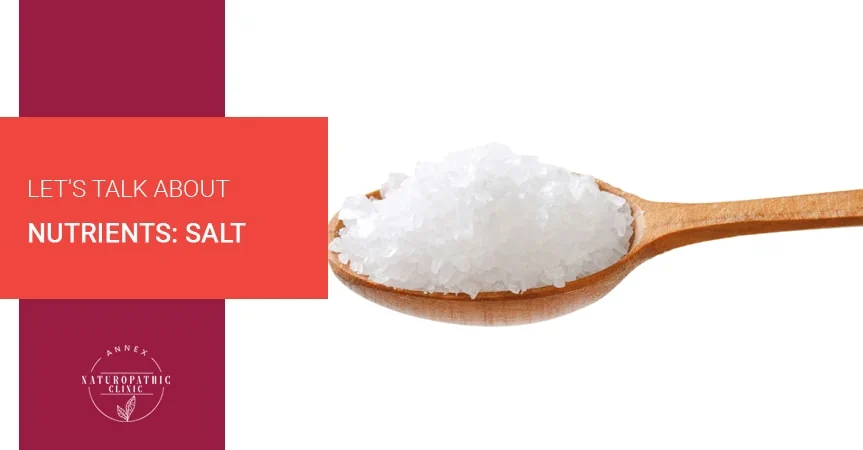Salt has been used for thousands of years as a flavoring agent, and its health impact has been coming to light now more than ever.
We crave it when we go to the movies, we use it to make our food last longer, and you probably even sprinkled some on your last meal.
If you’re a salt lover, consider chatting with a professional about how you can alter your intake to keep your cardiovascular system healthy naturally.
In the meantime, let’s talk about salt.
What Is Salt
In scientific terms, salt is known as sodium chloride (NaCl).
Sodium chloride is a compound that’s created when sodium (Na) and Cl (chlorine) combine to create crystalline cubes.
It’s an essential ionic compound for several of your body’s functions such, as:
- Regulating your fluid balance
- Maintaining blood pressure
- Absorption of nutrients
- The relaxation and contraction of muscles
- The transmission of nerve signals
However, that doesn’t mean you should load up on salt for every meal.
Salt in the wrong quantities can have a detrimental effect on your health.
Is Sodium And Salt The Same Thing?
It’s common for folks to assume that the words salt and sodium have the same definition, but they are different compounds.
Sodium is a naturally occurring nutrient and mineral.
Salt is a combination of the elements sodium and chloride.
A quick rule of thumb, if it’s already present in your unprocessed food, it’s most likely sodium.
If you’re sprinkling it on top of your food or using it for preservation, it’s salt.
Health Benefits Of Salt
In the right amount, salt hosts a myriad of benefits.
However, given how easy it is to overindulge on it, take these benefits “with a grain of salt.”
1. Keeps You Hydrated
Salt can help promote your body’s organ functions.
By encouraging your body to stay at a healthy hydration level, and balancing your electrolytes, salt ensures that there is a steady flow of fluids to tissues, muscles, and cells.
This is great news considering that dehydration can increase your chances of fatigue, muscle cramps, and dizziness.
2. Aids In Thyroid Function
To combat the growing numbers of people with iodine deficiencies in the world, many salt companies began adding iodine to their salts in the 1920s.
Iodine plays a key role in your body’s creation of thyroid hormones.
Thyroid hormones are created by your thyroid, as the name suggests.
They work to regulate your metabolism.
If you have a deficiency in thyroid hormones (hypothyroidism) it can lead to symptoms such as:
- Sensitivity to cold
- Constipation
- Chronic fatigue
- An enlarged thyroid (goiter)
- Difficulty thinking
3. May Help Manage Cystic Fibrosis
One of the symptoms of cystic fibrosis is an excessive loss of salt through sweat.
It’s important for those living with cystic fibrosis to increase their water and salt intake to avoid dehydration.
However, always check with your doctor before altering your diet.
4. Helps Regulate Blood Pressure
Low sodium in your diet can increase your risk of low blood pressure.
Low blood pressure, also known as hypotension, can look like fainting, dizziness, blurry vision, and nausea.
But I Thought Salt Was Bad!
Salt isn’t inherently bad, but the overconsumption of it can be.
One teaspoon of table salt contains approximately 2325 milligrams (mg) of sodium.
Compare this to the daily recommendation of 2300 mg of sodium for healthy children and adults, and it’s not hard to see how the majority of us overindulge.
In fact, on average, North Americans consume about 3400 mg of sodium a day.
That’s over 1000 mg more salt than the recommended amount for a healthy adult, and that’s not even accounting for people who live with existing conditions.
If you live with high blood pressure, kidney disease, or diabetes (type 1 or type 2), it’s recommended that you limit yourself to 1500 mg of salt a day.
And that’s 1900 mg below the daily average of salt consumption for North Americans.
Here are some of the dangers of overindulging in salt.
1. Increases Your Risk Of Osteoporosis
If you consume high amounts of salt and don’t increase your intake of calcium, you can put yourself at risk for bone disorders like osteoporosis.
Calcium is needed to maintain healthy bones, and salt can amplify your calcium loss through urination.
This loss of calcium is triggered by table salt and added salt.
Naturally occurring sodium in fresh food isn’t directly linked to this issue, but it is an issue for processed foods.
2. May Cause Stomach Cancer
Including high levels of salt in your diet can increase your risk for stomach cancer.
Researchers have found a correlation between salt and damage to your stomach lining.
If those lesions are unattended, they can develop into stomach cancer.
If you already suffer from the presence of H. pylori bacteria, which harms the stomach lining, salt can intensify its damage.
Salt can also cause damage to your gastric mucus.
This damage can lead to parietal cell loss and the development of gastric cancer.
Limiting your salt is a plausible strategy for lowering your risk of gastric cancer.
3. May Cause Water Retention
Too much salt can make it difficult for your kidneys to filter extra sodium out of your bloodstream.
As your sodium levels rise, your body will horde excess water in an attempt to dilute it.
This retention of water can cause bloating and uncomfortable swelling in the legs, ankles, hands, and feet.
4. Can Lead To Poor Cardiovascular Health
When your body holds onto excess water, it can create an added strain on your blood vessels and heart.
This strain can trigger high blood pressure.
High blood pressure is a leading cause of stroke and heart attack.
5. It’s Hard On Your Kidneys
Your kidneys use a process called osmosis to remove excess water from your body.
Osmosis is when your kidney acts as a filter for your blood, catching the parts that you want to keep, and separating the extra fluid that you don’t.
For osmosis to function it needs a proper balance of your body’s sodium and potassium levels.
This balance is what allows your kidney to pull water from the bloodstream and place it into a collecting channel.
When you consume too much sodium, your kidney’s ability to filter is reduced, and it can’t pull as much water.
This creates high blood pressure within the body, and a strain on the kidneys.
Prolonged periods of strain can lead to kidney disease.
High salt intake is also linked to an increase of protein in your urine.
High levels of protein in your urine are linked to excess urinary calcium and kidney stones.
Kidney stones can make it painful to pass urine and can cause nausea.
If untreated, they can cause a blockage that increases your risk of kidney disease.
Symptoms Of Salt Deficiency
Salt deficiency is extremely rare in North America, as we consume a lot of processed food and often use salt as a seasoning.
However, if you suspect that you may have a salt deficiency keep an eye out for the symptoms below.
Symptoms of a salt deficiency include:
- Headache
- Confusion
- Irritability
- Vomiting
- Nausea
- Weakness
- Muscle spasms or cramps
- Fatigue
Most times a sodium deficiency is the sign of an underlying condition called hyponatremia.
Hyponatremia can be caused by issues such as:
- Kidney disease
- Excessive water intake
- A lengthy period of vomiting or diarrhea
- Unusual secretion of antidiuretic hormone (ADH)
In general, unless you’re suffering from hyponatremia, you should only worry about a sodium deficiency if you’re involved in activities that cause you to sweat excessively.
How To Reduce The Salt In Your Diet
Reducing your salt intake can be beneficial to your overall health.
It’s always a good idea to check in with your naturopathic doctor before creating a new diet plan though.
They may be able to offer helpful suggestions and to keep an eye on any other aspects of your health that may be impacted.
Below are some simple steps to take on your journey to salt reduction.
1. Read The Label
If you’re looking to reduce your salt intake, you can start by checking your food labels.
Avoid food that has over 200 mg of sodium in one serving.
Even if a product is branded as being reduced or without salt, check the ingredients to see if it contains sodium as a replacement.
This is also true because some products are extremely high in salt, and “reduced salt” might still be an unhealthy amount.
2. Include More Fresh Fruits And Veggies
Fresh fruits and vegetables may have naturally occurring sodium, but they lack added salts.
Where preserved and processed foods use salt to keep them edible longer, fresh vegetables and fruit are traditionally left untouched.
Filling up on these types of food can lower your consumption of heavily salted dishes.
3. Avoid Preserved Foods
Salt is excessively used in pickling and preserving food.
This is why canned and bottled foods have much higher salt levels on their labels.
Many restaurants and take out places buy their ingredients in bulk, and to ensure their use before going bad, those ingredients are often loaded with preservatives.
If you can focus your diet around fresh foods and home cooking, you’ll notice a change in your salt consumption.
You can still enjoy a nice meal out – just have a look at the restaurant’s menu online ahead of time.
Many restaurants carry low sodium and fresh food options.
4. Experiment With Other Herbs & Spices In Your Cooking
If cutting out salt has your food tasting bland, try swapping out salt with other herbs and spices while you cook.
Plenty of recipes call for alternative seasonings, such as garlic, chili, rosemary, cumin, or oregano.
Unlike your parents, we encourage you to play with your food until you find out what spices work for you.
Salt can be addictive, so the more you can wean yourself off of its flavor, the higher your chances of keeping it out of your diet.
Book An Appointment With Annex Naturopathic
Curious about how reducing your salt intake could be beneficial to you? Contact us to book an appointment today with one of our naturopathic doctors in Toronto.



